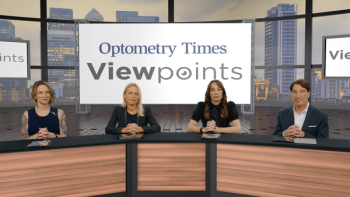
- July/August digital edition 2025
- Volume 17
- Issue 04
Case report: Gyrate atrophy of the choroid and retina

Gyrate atrophy of the choroid and retina is a form of choroidal sclerosis and is a rare, progressive, autosomal recessive, inherited genetic disease that primarily affects the ocular tissue.
A Black male patient approaching aged 40 years with progressive distance vision loss over 2 decades and a history of long-term alcohol use presented with “hand motion” visual acuity in both eyes. He had no prior use of glasses but had received a low vision device for near tasks. Fundus examination revealed geographic atrophy, retinal pigment epithelium hyperplasia, and multiple areas of chorioretinal atrophy throughout the fundus of both eyes, with some confluent lesions. Fundus autofluorescence imaging showed hypofluorescent lesions, and optical coherence tomography (OCT) revealed macular atrophy, retinal thinning, and choroidal sclerosis. The left eye showed choroidal excavation, possible subretinal fluid, and choroidal neovascular membrane (CNVM). Based on these findings, the diagnosis of gyrate atrophy, a form of choroidal sclerosis, was made. Management included a referral to a retina specialist for evaluation of possible CNVM and to a primary care provider to monitor ornithine aminotransferase levels. The patient’s lack of medical insurance was addressed, and options for insurance assistance, disability benefits, alcohol rehabilitation, and a low vision exam were discussed.
Case report
Patient information
A 38-year-old Black male patient presents with his sister for evaluation of reduced vision at distance, more than near, since childhood. He reported that his vision had been progressively getting worse over the past 2 decades. He has not used glasses in the past but was previously evaluated by a low vision specialist in Haiti and was provided with a low vision device for near tasks. The patient’s sister reported long-term alcohol use since the patient was 14 years old. Both the patient and his sister were unclear about his past ocular history. The patient was diagnosed with hypertension and was hospitalized for 1 week due to an alcohol overdose 5 months ago.
Clinical findings
- Visual acuity: Vision in both eyes was classified as hand motion, with no improvement with pinhole or corrective lenses.
- IOP and angles: IOP was 20 mm Hg in the right eye and 18 mm Hg in the left eye. The van Herick test revealed narrow angles in both eyes. Gonioscopy was performed to ensure safe dilation.
- Anterior segment examination: 2+, inferior, coalesced punctate epithelial erosion in both eyes.
- Fundus examination: Fundus examination of the right (Figure 1a) and left (Figure 1b) eyes revealed geographic atrophy with retinal pigment epithelium hyperplasia in the macula. Scattered areas of pigment epithelial hyperplasia were noted throughout the fundus. Multiple, well-circumscribed, circular, paving stone–like areas of chorioretinal atrophy were noted, with visible underlying choroidal vessels. Some lesions merged to create a large, confluent area of atrophy, with islands of preserved retina between the lesions.
Imaging findings
Fundus autofluorescence of the right (Figure 2a) and left (Figure 2b) eyes revealed multiple, well-circumscribed, circular, hypofluorescent, paving stone–like lesions around the optic nerve and throughout the fundus, including the macula of both eyes. Some lesions merged to create a large, confluent area of atrophy, with islands of preserved retina between the lesions.
Spectral-domain SD-OCT of the right eye (Figure 3a and 3b) using AngioVue SD-OCT (Optovue, Inc) revealed loss of foveal contour secondary to complete atrophy of the macula, generalized thinning of the neurosensory retina, and choroidal sclerosis. There was disruption, thinning, and loss of the photoreceptor integrity line, with multiple hypertransmission defects. No intraretinal fluid or subretinal fluid was observed, and no choroidal neovascular membrane (CNVM) was seen.
Optovue SD-OCT of the left eye (Figure 4b and Figure 4c) revealed abnormal foveal contour secondary to atrophy of the macula, generalized thinning of neurosensory retina, and choroidal sclerosis. Disruption, thinning, and loss of photoreceptor integrity line were noted, with multiple hypertransmission defects. No intraretinal fluid was observed. There was choroidal excavation, with suspicious subretinal fluid and a possible CNVM (Figure 4a and Figure 4d).
Differential diagnosis
The differential diagnosis of diffuse chorioretinal atrophy throughout the fundus includes retinitis pigmentosa, gyrate atrophy of the choroid, rod-cone dystrophy, choroideremia, myopic degeneration, cobblestone degeneration, diffuse choriocapillaris atrophy, and multifocal choroiditis.2
The funduscopic examination revealed well-defined, circular, paving stone–like areas of chorioretinal atrophy. Fundus autofluorescence imaging showed sharply delineated areas of increased or preserved signal extending beyond the macula, all of which are characteristic of gyrate atrophy, a form of choroidal sclerosis, which was the working diagnosis for our patient. The patient demonstrated advanced disease. Intraretinal cystic spaces, typically seen in the early stages, and outer retinal tubulation, observed in late stages, were not present in our patient.
Management
The patient and his sister were reassured about his current condition and the treatment plan, and the potential risks of disease progression were addressed. Potential options for medical insurance assistance were explored. A referral to a retina specialist was made for evaluation of possible CNVM. Additionally, the patient was referred to a primary care provider to monitor ornithine aminotransferase levels to confirm the diagnosis and assess for further potential treatment. Disability benefits, alcohol rehabilitation, and a low vision exam were also discussed.1
Discussion
Gyrate atrophy of the choroid and retina (GACR) is a form of choroidal sclerosis. It is a rare, progressive, autosomal recessive, inherited genetic disease that primarily affects the ocular tissue. It is caused by various mutations in the ornithine aminotransferase (OAT) gene, leading to a deficiency in the OAT enzyme. This leads to protein degradation and a subsequent 10 to 20 times increase in the plasma level of the amino acid ornithine concentrations.2
Other nonocular systemic manifestations related to elevated ornithine levels include muscle weakness and wasting, growth retardation, and mild cognitive impairment.3-5
GACR has been reported worldwide, with the highest prevalence in Finland (approximately 1 in 50,000).6 The condition is marked by progressive chorioretinal degeneration, leading to chorioretinal atrophy and gradual vision loss. It typically manifests early, often in the first decade of life. 2 Nyctalopia, myopia, and well-circumscribed circular chorioretinal atrophy scattered in the peripheral retina are common signs in the early stages of the disease. The atrophic lesions coalesce and spread centripetally toward the posterior pole as the disease progresses.7 Macular involvement, including cystoid macular edema, epiretinal membrane, and CNVM, typically occurs in the later stages of the disease.7
Diagnosis of GACR is largely based on history and clinical presentation. The diagnosis can also be confirmed through elevated systemic ornithine levels and genetic sequencing tests. Fundus photography, particularly widefield imaging, aids in the early detection of peripheral chorioretinal atrophy and monitoring disease progression. Fundus autofluorescence helps assess disease severity, with hypofluorescent lesions corresponding to areas of chorioretinal atrophy. OCT is valuable for monitoring macular changes and generalized retinal alterations. These imaging modalities are essential in confirming the diagnosis, tracking disease progression, and evaluating potential complications, such as CNVM.
Vision loss in GACR is usually slow and progressive. Among individuals with GACR, 37% at aged 30 years and 64% at aged 40 years reported 20/200 vision or worse.6 For our patient, initial vision was hand motion in both eyes, with no improvement with pinhole or corrective lenses. The patient had a long history of alcohol abuse starting at aged 14 years. Although, to our knowledge, there are no specific studies linking alcohol consumption to the progression of GACR, Duic et al found that high alcohol intake (more than 2 standard drinks daily) was associated with faster progression of geographic atrophy in age-related macular degeneration.8
Currently, there is no curative treatment for GACR. Due to the slow progression and rarity of GACR, management primarily focuses on addressing complications and improving quality of life. A low vision specialist plays a key role in assisting with adaptive strategies, and treating complications such as cystoid macular edema and CNVM is essential to prevent further vision loss.
The challenge in our patient’s case is that he is uninsured and lacks basic primary care. To manage his ocular condition, the patient first needs to establish health care locally, potentially through a patient assistance program, to obtain some form of medical coverage. This will involve a primary care provider, retinal specialist, low vision specialist, and alcohol rehabilitation services. The involvement of social workers also may be necessary to help navigate disability benefits and assist with the patient’s activities of daily living.
Conclusion
In this case of GACR, the patient presented with advanced disease with significant visual impairment, a history of alcohol use, and lack of access to health care. Although no curative treatment exists, management focuses on slowing disease progression, addressing complications, and improving quality of life.
References:
Sergouniotis PI, Davison AE, Lenassi E, Devery SR, Moore AT, Webster AR. Retinal structure, function, and molecular pathologic features in gyrate atrophy. Ophthalmology. 2012;119(3):596-605. doi:10.1016/j.ophtha.2011.09.017
Elnahry AG, Tripathy K. Gyrate atrophy of the choroid and retina. StatPearls [Internet]. StatPearls Publishing; August 2023. Accessed June 20, 2025. https://www.ncbi.nlm.nih.gov/books/NBK557759/
Stoppoloni G, Prisco F, Santinelli R, Tolone C. Hyperornithinemia and gyrate atrophy of choroid and retina: report of a case. Helv Paediatr Acta. 1978;33(4-5):429-433.
Valtonen M, Näntö-Salonen K, Jääskeläinen S, et al. Central nervous system involvement in gyrate atrophy of the choroid and retina with hyperornithinaemia. J Inherit Metab Dis. 1999;22(8):855-866. doi:10.1023/a:1005602405349
Lahbil D, Hamdani M, D’khissy M, et al. [Gyrate atrophy of the choroid and retina: a case report]. Abstract in English. J Fr Ophtalmol. 2000;23(8):788-793.
Takki KK, Milton RC. The natural history of gyrate atrophy of the choroid and retina. Ophthalmology. 1981;88(4):292-301. doi:10.1016/s0161-6420(81)35031-3
Tripathy K, Chawla R, Sharma YR, Gogia V. Ultrawide field fluorescein angiogram in a family with gyrate atrophy and foveoschisis. Oman J Ophthalmol. 2016;9(2):104-106. doi:10.4103/0974-620X.184529
Duic C, Vance E, Agrón E, Keenan TDL; AREDS2 Research Group. Alcohol consumption and risk of age-related macular degeneration and geographic atrophy progression: Age-Related Eye Diseases Study 2 report 34. Ophthalmol Retina. 2025;9(3):200-211. doi:10.1016/j.oret.2024.11.006
Articles in this issue
3 months ago
Myopia is an escalating global health crisis4 months ago
Inside genetics and glaucoma4 months ago
Embracing dry eyeNewsletter
Want more insights like this? Subscribe to Optometry Times and get clinical pearls and practice tips delivered straight to your inbox.













































.png)


